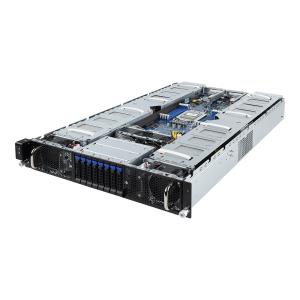

AMD EPYC Processors
The New x86 Option
AMD’s return to the CPU segment delivers a whole new value proposition to the x86 world. Built on GIGABYTE’s extensive design expertise across a range of chipset platforms, this AMD EPYC platform is already receiving acclaim for its high specification:
Memory
I/O
Network connectivity
This platform is intended as an alternative for builders in the x86 space and packs a real punch in flexibility and expansion options.
Comprehensive I/O
Both single- and dual-socket CPUs come equipped with 128x PCIe lanes, providing extensive I/O options. This is a huge improvement in I/O vs. incumbent x86 offerings.
Increased I/O allows for flexibility in extending your storage, networking or compute to a level previously unattainable with standard server motherboards.
In addition, the integrated nature of the processor – designed as a system-on-chip (SoC) - means that there is no need for a separate PCH and less additional switches needed for expansion lanes.
High Density HPC
Supports 8 x Computing Cards
Able to support up to 8 double slot GPGPU or co-processor cards, the G291 enables world-leading HPC within a 2U chassis. The G291 is ideal for HPC applications such as real time analytics, programs in scientific simulation and modeling, engineering, visualization & rendering, data mining, and much more.
NVIDIA V100 Tensor Core GPU Support
GIGABYTE’s AMD EPYC server systems and motherboards are fully compatible and qualified to use with NVIDIA V100 Tensor Core GPUs, an advanced data center GPU built to accelerate AI, HPC, and graphics. Powered by NVIDIA Volta architecture and with 640 Tensor Cores, the NVIDIA V100 has broken the 100 teraflops (TFLOPS) barrier of deep learning performance — enabling data scientists, researchers, and engineers to tackle challenges that were once impossible.
High-Speed Networking
GIGABYTE offers 10Gb across dual ports on-board, ensuring that users can get the most out of their system and are well equipped for today’s traffic demands. The server’s network performance is boosted with full-line rate throughput and CPU overhead is reduced, leaving the EPYC to focus on the real compute tasks.
Dense, High Speed Storage Support
Onboard M.2
GIGABYTE AMD EPYC platforms are designed to support on-board ‘M.2’ storage devices for time-sensitive operations and leaves room on the standard storage for compute tasks. Delivering up to 32 Gb/s data transfer speeds, M.2 offers users considerably faster storage performance than current mSATA devices.
Data Security
TPM 2.0 Module
GIGABYTE’s EPYC platform is designed to support Trusted Platform Modules (TPM - discrete cryptographic on-board processors).
Carefully Selected Components
GIGABYTE’s passive components are carefully selected to guarantee a stable operating environment and allow the processors and the memory to deliver their maximum performance. GIGABYTE’s server motherboards are built with long lasting components for a high degree of reliability and durability.
Ease of Deployment and Management
GIGABYTE continues to be responsive to market needs and to create user-friendly solutions, including:
Tool-less rail kit included as a default across all new server models
Supplying multiple connector options and tools where appropriate
Efficient, Reliable Power Supply
GIGABYTE SERVER AMD EPYC servers are designed to guarantee high conversion efficiency regardless of load. Redundant 80 Plus ‘Titanium’ or ‘Platinum’ PSUs, combined with GIGABYTE’s precision engineering, translates to super efficient power usage which maximizes the system’s power : performance ratio and reduces OPEX for the user.
Intelligent Power Management Features
SCMP (Smart Crises Management / Protection)
SCMP is a GIGABYTE patented feature that will automatically force the system’s CPU to enter ULFM (ultra-low frequency mode for minimum power consumption) when the BMC is alerted to a PSU fault or error (such as power loss, power surge, overheating or a fan problem). This feature will prevent shutdown in systems with less than 1 + 1 PSU redundancy when one PSU is lost. In a 2U 4 Node server, only two nodes will be switched to low power mode, while two remaining nodes can continue normal operation. When the fault is resolved or the PSU is replaced, the system will automatically return to normal power mode.
GIGABYTE Server Management (GSM) is GIGABYTE’s proprietary multiple server remote management software platform, available as a free download from each GIGABYTE server product page. GSM is compatible with either IPMI or Redfish (RESTful API) connection interfaces, and comprises the following sub-programs:
GSM Server, a software program with an easy to use browser-based GUI to enable global remote monitoring and management of multiple GIGABYTE servers via each server node’s BMC.
GSM CLI, a command-line interface program to enable global remote monitoring and management of multiple GIGABYTE servers via each server node’s BMC.
GSM Agent, a software program installed locally on each GIGABYTE server node that retrieves additional node information (CPU/Mem/HDD/PCI/…) from the OS and passes it to the BMC. This information can then be utilized by GSM Server or GSM CLI.
*GSM Agent is currently compatible with Avocent MergePoint IPMI 2.0 BMC firmware, but not yet compatible with Megarac SP-X BMC firmware.
GSM Mobile, a remote server management mobile APP, available for both Android and iOS.
GSM Plugin, a plugin that allows the user to manage and monitor GIGABYTE server nodes within VMware’s vCenter.
Intuitive & Informative User Interface
Starting from the GSM Server dashboard, the user can clearly understand the status of each node in the IT environment, including:
Node connection status (system is online/offline)
Node hardware sensor status (to detect hardware anomalies). Sensors measure voltage, fan speed and temperature
Node usage rate status (allowing you to timely allocate more resources when they are needed), including:
Power consumption
Disk/RAID usage information
Memory usage rate
CPU usage rate
Network card / PCI information
These cookies ensure that the webstore functions properly. Think of keeping track of your language and your products in your shopping basket, log on with your account, the checkout form, filter search results etc.
We use analytical and tracking cookies to see how we can improve the webstore and how we can adapt content and potential advertisements to your preference.
